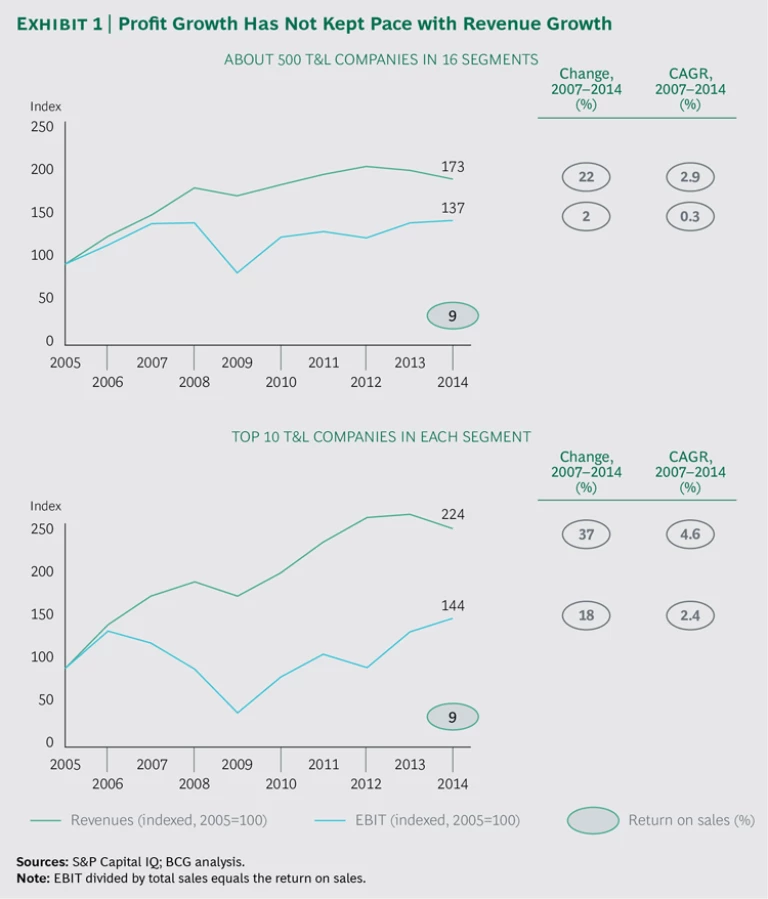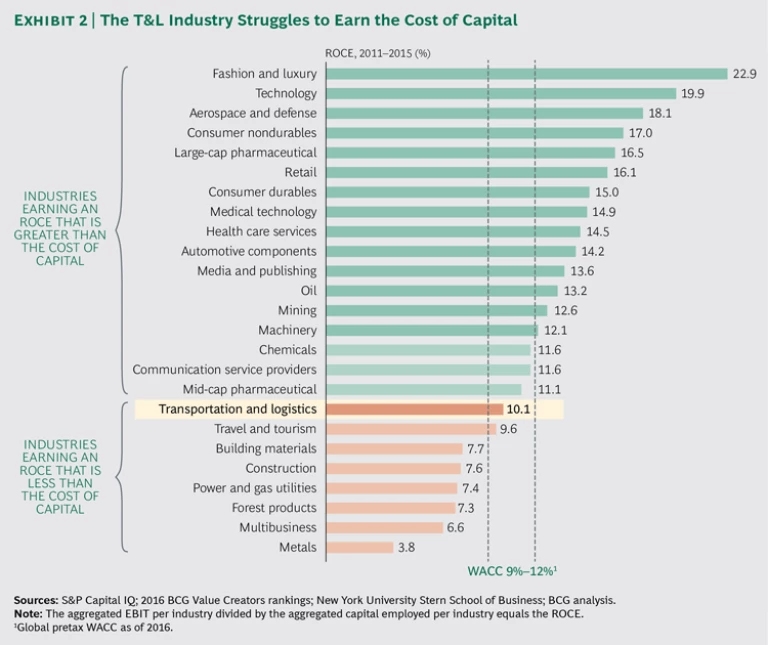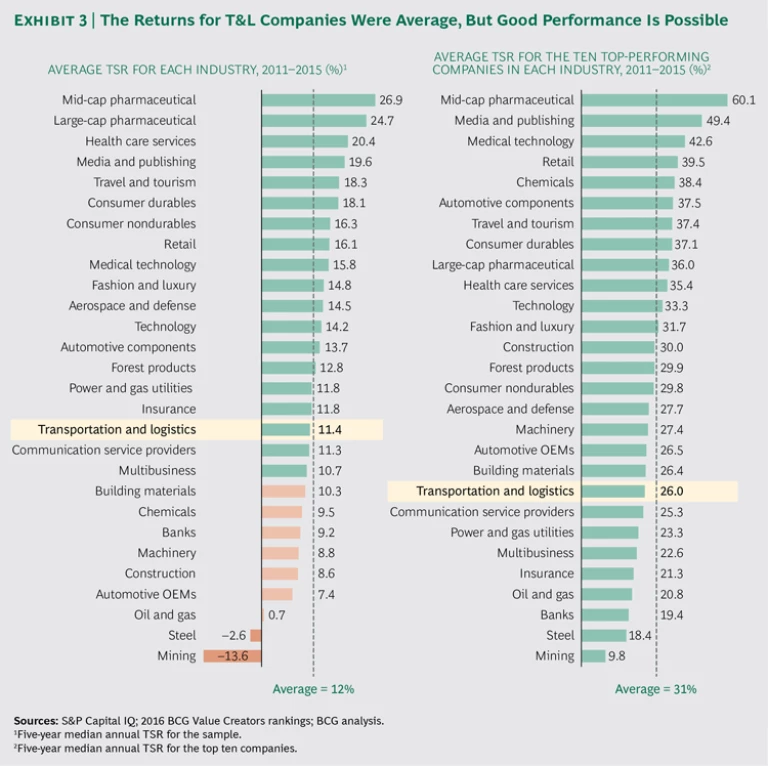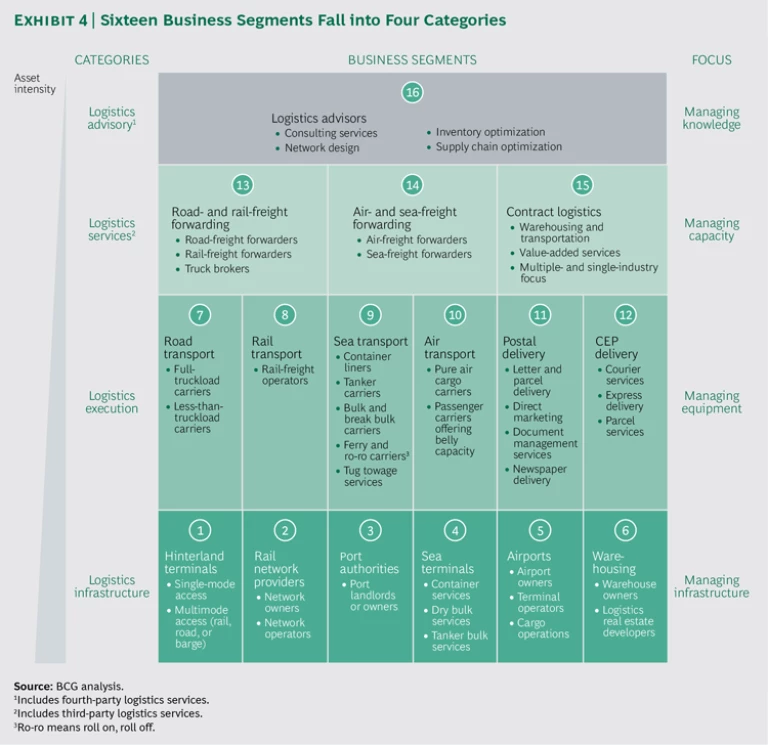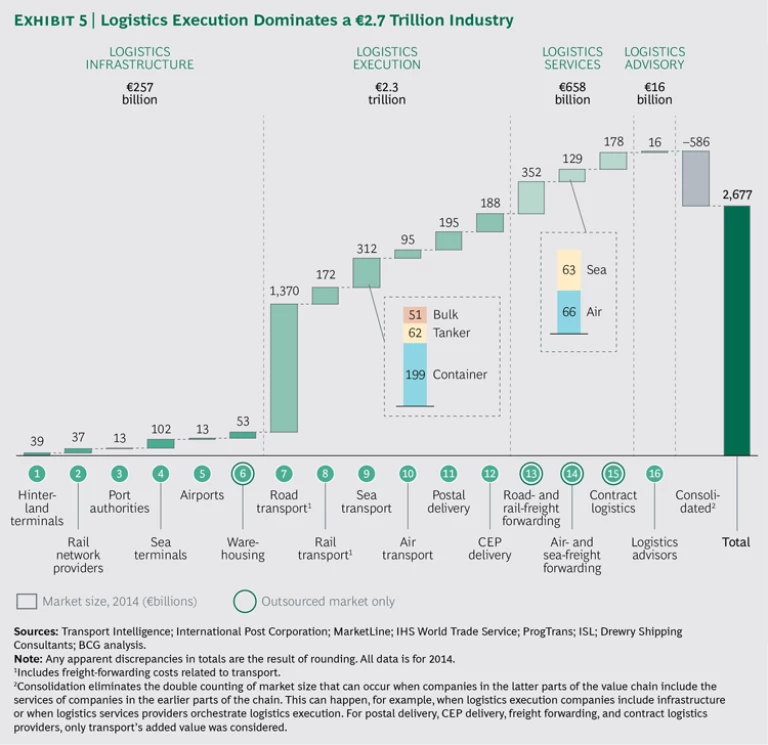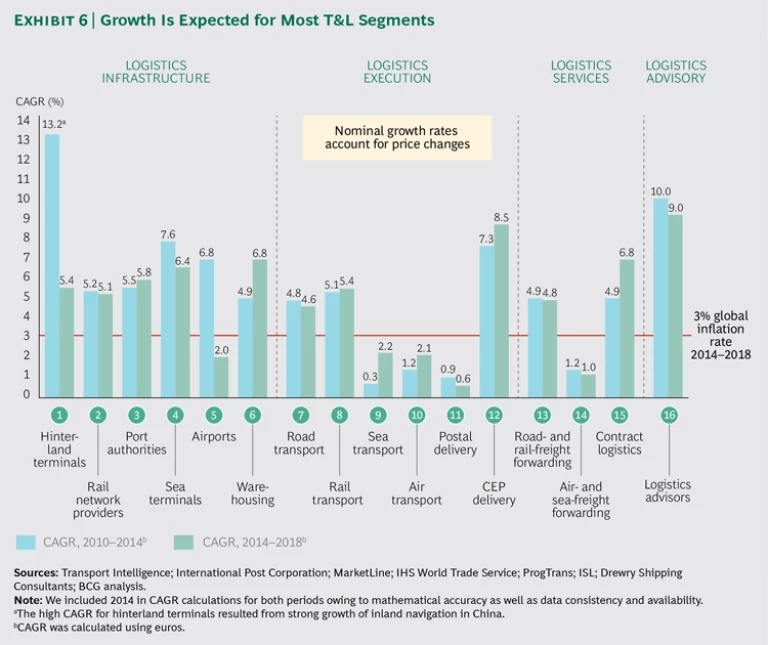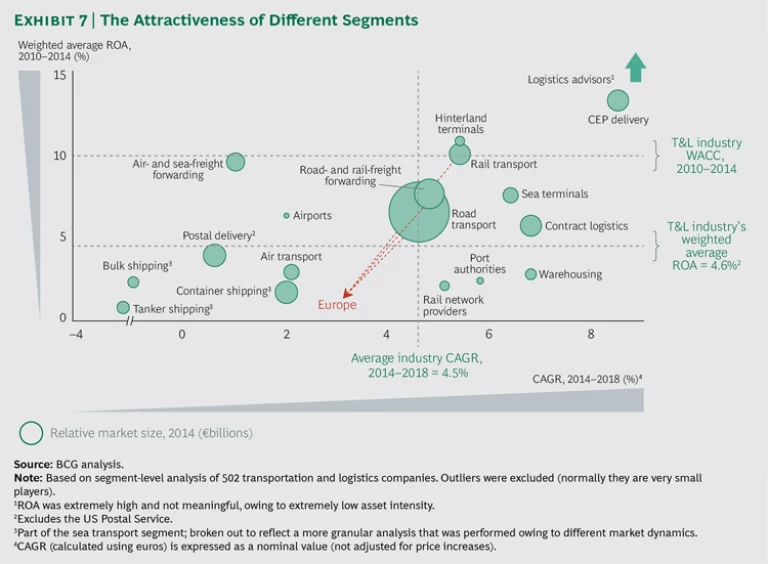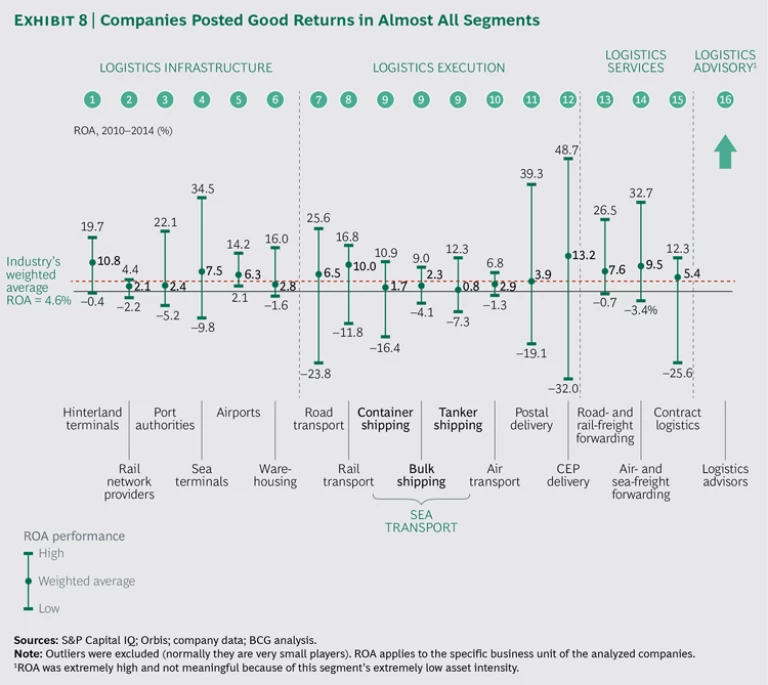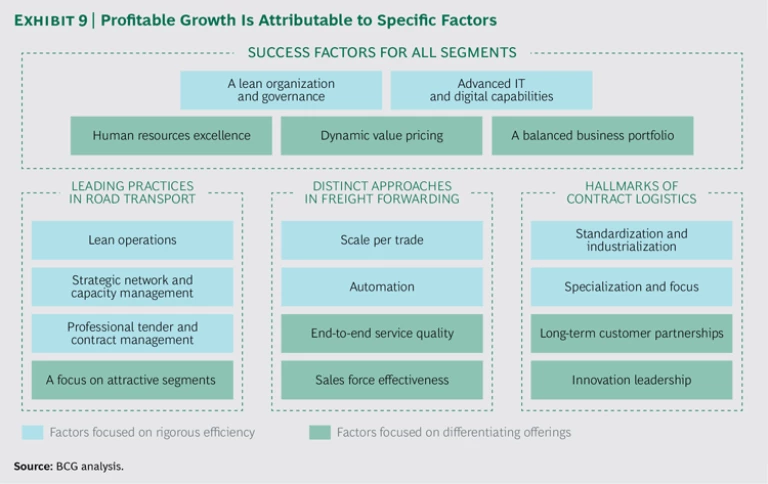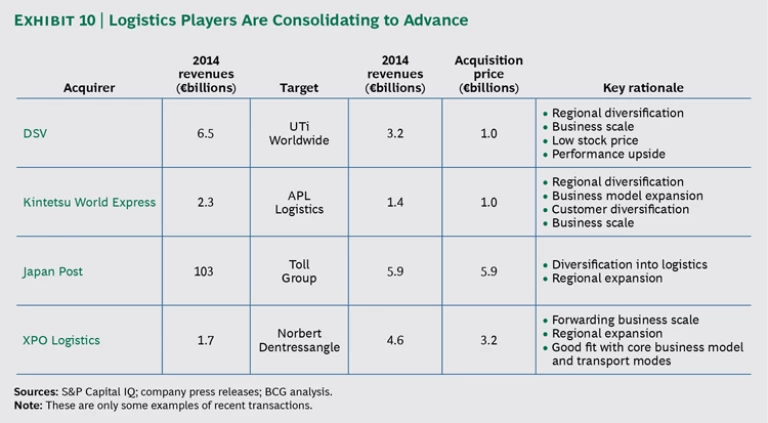The Elusive Goal of Profitable Growth
Are these good times or bad times for the transportation and logistics (T&L) industry ? The industry has grown significantly since the turn of the millennium, and most segments emerged from the 2008 financial crisis with strong growth prospects. Despite sound revenue growth, however, only a few T&L companies have managed to enjoy higher profits.
Related article: Getting Ahead of the Megatrends in Transportation and Logistics
The Boston Consulting Group analyzed the revenues and margins (calculated using earnings before interest and taxes, or EBIT) of approximately 500 T&L companies worldwide. We found that revenues and average EBIT margins grew at nearly the same rate from 2005 through 2007. Then, a small gap between the two increasingly widened. By the end of 2014, revenues had grown by 22%, while EBIT margins had grown by only 2%. (See Exhibit 1.)
Challenging market conditions only partially explain why profits did not keep pace with revenue growth. For many T&L players, organic growth strategies aimed at gaining market share in new regions and in new business segments failed to deliver profitability in terms of return on sales (ROS) and return on assets (ROA). In some instances, companies accelerated revenue growth through acquisitions, but these inorganic strategies also failed to realize the anticipated profit growth—often because the companies did not adequately integrate the acquired businesses into their operations and networks.
However, some T&L companies succeeded in achieving strong growth in both revenues and profits. The top ten companies in each of 16 market segments were able to increase revenues by 37% from 2007 through 2014, and their EBIT margins grew by 18% during the same period. To determine how, we conducted an industry-level analysis of critical performance metrics and complemented it with detailed analyses of business segments and individual companies. We found that the top-performing companies set themselves apart in two ways: they understand the success factors and related best practices that are critical to maximizing their profits in the market today, and they proactively position themselves to capture opportunities arising from the megatrends reshaping the global economy —such as urbanization and digitization—so as to maintain their competitive advantage.
To capitalize on opportunities in industry segments that are attractive in terms of both growth and returns, company executives need to refine their current business models, keeping in mind the factors that promote success in the near term and the megatrends that will affect these segments in the long term. For many T&L companies, joining the ranks of the top performers will require a fundamental paradigm shift—from pursuing growth for its own sake to finding avenues for growth that generate high returns in an increasingly complex and competitive business environment.
Assessing the Industry’s Performance
We evaluated the growth and returns of the T&L industry, its business segments, and the companies within each segment.
Growth Has Not Led to High Returns
Although the T&L industry is huge and growing, its return on capital employed (ROCE) and total shareholder return (TSR) have been comparatively low. The
Additionally, we compared industries’ ROCE with their weighted average cost of capital (WACC). An industry’s WACC quantifies the cost of the capital required to finance the purchase of assets, reflecting investors’ expectations for returns when they provide capital. If ROCE exceeds WACC, a company is earning the cost of the capital required to run its business.
The T&L industry’s WACC of 10.3% signals that investors attributed a relatively low risk to the industry, which is consistent with its maturity and structural importance. However, the fact that ROCE was 0.2% less than WACC should be a source of concern for the T&L industry. It indicates that, on average, T&L companies were not earning their cost of capital, let alone excess value. Given that asset intensity is inherently high for many industry segments and that the industry’s WACC reflects reasonable investor expectations, T&L companies should be looking for ways to improve their ROCE—ways that increase margins, improve the utilization of assets, or better manage capital expenditures.
Not surprisingly given its low ROCE, the T&L industry also did not reward its shareholders with high returns compared with other industries. During the five-year period from 2011 through 2015, the
Performance Varied Widely Among Segments
To gain a better understanding of what drives returns for the T&L industry, we took a closer look at its business segments and compared their growth rates and returns.
- Sixteen Segments Within Four Broad Categories. T&L businesses can be grouped into 16 segments on the basis of the service provided. These segments can in turn be grouped into four categories on the basis of asset intensity. (See Exhibit 4.)
- Logistics infrastructure comprises segments for which the management of infrastructure is the most important task. These segments are hinterland terminals, rail network providers, port authorities, sea terminals, airports, and warehousing. The segments in this category typically have the highest asset intensity in the industry. Companies must make significant investments to acquire and maintain their assets, creating a high entry barrier for new competitors.
- Logistics execution comprises segments that emphasize the management of equipment. This category includes four transport segments: road, rail, sea, and air. It also includes two delivery segments: postal and courier and express parcel (CEP). Although execution segments are typically less asset intensive than infrastructure segments, companies must own or rent fleets for transporting freight.
- Logistics services, or third-party logistics, comprises three segments: road- and rail-freight forwarding, air- and sea-freight forwarding, and contract logistics; the management of capacity is their main focus. Freight-forwarding players manage transport services. Road and rail forwarding companies have similar economics arising from the similarity of their customers; the same is true for air and sea forwarding providers. Contract logistics players manage value-added services related to warehousing and transport, such as supply chain management. Because companies in these three segments provide only management services, their asset intensity is low (unless they have a more asset-intensive business, such as owning warehouses).
- Logistics advisory includes all fourth-party logistics services, such as consulting and IT services, for transport and transport-related businesses. Advisory businesses typically have very low asset intensity because they provide knowledge-based services.
The segments differ significantly with respect to their market size on a global basis. We measured the market size of segments in terms of combined company revenues. In some cases, segments are integrated. For example, in some countries, rail network providers are integrated into rail transport companies; in such cases, we attributed a share of transport companies’ revenues to their network operations. Additionally, we considered only the share of revenue attributable to freight transport for companies that provide both freight and passenger transport.
The €2.7 trillion T&L market is dominated by logistics execution, with combined revenues for its segments of €2.3 trillion. (See Exhibit 5.) Road transport is the largest segment, with revenues of €1.4 trillion. Sea transport is the second largest segment (€312 billion). This segment is dominated by container shipping (€199 billion), owing to the relative ease and efficiency of transporting freight by this standardized mode. Tanker shipping (€62 billion) and bulk shipping (€51 billion) represent much smaller shares of the segment.
Eleven percent of costs in the execution segments relates to the use of logistics infrastructure, but these costs vary by segment. We found that rail network costs account for 22% of rail transport costs. Costs for sea terminals (excluding hinterland terminals) are approximately 30% of sea transport costs. Costs relating to airports represent only 14% of air transport costs; fuel and other transport costs unrelated to airports are relatively high due to the longer distances traveled in air transport. Overall, infrastructure segments’ revenues from serving execution segments total €257 billion.
In the €658 billion market for logistics services, road- and rail-freight forwarding is the largest of the three segments, with revenues of €352 billion. The €129 billion air- and sea-freight-forwarding market comprises services related to transport by air (€66 billion) and sea (€63 billion). The contract logistics segment has total revenues of €178 billion. The emerging category of logistics advisory currently represents less than 1% of the overall T&L market.
Diverging Growth Rates Among Segments. All industry segments grew from 2010 through 2014, and this growth is expected to continue from 2014 through 2018. (See Exhibit 6.) For most segments, the forecast nominal compound annual growth rate (CAGR), which is adjusted for price changes, is 4% to 7%. Macroeconomic conditions affecting the T&L industry are expected to promote a growth rate for many segments that exceeds the global inflation rate during this period.
The logistics advisors segment is expected to enjoy the highest CAGR: 9%. Growth will be driven in part by companies in the logistics services segments and by players from outside the industry expanding into or repositioning their offerings in the logistics advisors segment.
Warehousing, CEP delivery, and contract logistics are forecast to have particularly high CAGRs—each exceeding 6.5%. This growth will result from the continued strong growth of e-commerce, the growing demand for fulfillment solutions, and the ongoing trend of greater outsourcing. These developments will also support road- and rail-freight forwarding. These segments will also benefit as customers adopt more sophisticated T&L offerings. These freight-forwarding companies have developed more advanced IT solutions, and contract logistics players have expanded the scope of their offerings, such as providing services for the assembly of finished products and the preassembly of components.
Sea and air transport are forecast to have low CAGRs of just over 2%, while the forecast CAGR of the related air- and sea-freight-forwarding segment is 1%. This reflects the continuing price pressure caused by the significant overcapacity in these segments.
Logistics infrastructure segments, with the exception of the airports, are forecast to have high CAGRs of 5% to 7%. This growth will result from higher prices stemming from a scarcity of infrastructure. The growth rates of hinterland terminals are similar to those of the road and rail transport players they serve. An increasing number of shipments are transported by both road and rail, and hinterland terminals have seen their businesses grow as the switching point between these modes.
Road transport is the largest segment in terms of revenue. Its growth rate is forecast to be close to the T&L industry’s average CAGR of 4.5%. The rail transport segment is forecast to have above-average growth, owing to the expansion of rail infrastructure in rapidly growing regional markets. Growth will also be generated by governments’ efforts to promote rail transport as environmentally friendly.
The increased use of electronic communications will continue to drain revenues from the postal delivery segment.
Gauging Segment Attractiveness on the Basis of Growth and Returns. A segment’s growth rate is only one indicator of its attractiveness; to form a complete picture, we must consider profitability. ROA is critical for understanding whether T&L companies earned the cost of capital and provided a return to investors.
To gain a better understanding of segment attractiveness in terms of both growth and returns, we plotted each segment’s forecast CAGR from 2014 through 2018 and weighted average ROA from 2010 through 2014, as well as the range of the T&L industry’s WACC. Companies whose ROA was above the WACC at any point from 2010 through 2014 earned the cost of capital. (See Exhibit 7.)
The most attractive segment is logistics advisors, followed by CEP delivery, hinterland terminals and, to a lesser extent, rail transport (outside of Europe). For these segments, CAGR is projected to exceed the industry average, and their average ROA exceeded the cost of capital. In addition to expecting high growth rates, businesses in the logistics advisors segment enjoyed an extremely high ROA: asset intensity is very low because these companies offer only knowledge-based services; yet they can charge high prices for their expertise, resulting in very high margins.
The rail transport segment is asset intensive, but its ROA was above the cost of capital. The profitability of rail transport companies varies significantly among regions, though. Companies’ profitability depends on the level of competition that they encounter within their segment and from companies in other segments, as well as on the cargo mix in their markets. Profitability is much lower in Europe than in other regions, especially North America.
Four infrastructure segments—warehousing, sea terminals, port authorities, and rail network providers—are expected to enjoy high growth rates, but their returns were below the cost of capital. These segments are very asset intensive, which puts additional pressure on their ROAs and results in many companies in these segments having returns below the industry average. In addition, rail network providers and port authorities are often regulated, which typically limits the access rates they can charge. The relatively low profitability of warehousing is explained by the large investments needed to build and regularly upgrade the assets.
Compared with logistics advisors, contract logistics players had a relatively low ROA, because they often need to make significant investments in assets. Additionally, the margins of contract logistics players were under pressure in a competitive market for value-added services.
The road transport segment’s projected CAGR equals the industry average. However, its ROA was below the cost of capital, reflecting the relatively low barriers to entry and the fragmented competitive landscape. Once again, European players had a lower ROA and their CAGRs will follow, owing to the more intense intra- and intermodal competition on the Continent.
The segments facing the most intense pressure in terms of both ROA and growth are air and sea transport and postal delivery. The air transport segment faces tremendous pricing pressure on various fronts, including the need for pure air cargo carriers to compete with passenger carriers that offer their “belly capacity” for freight shipments.
Sea transport segments—container, bulk, and tanker—had a low ROA owing to overcapacity in the market and the industry’s very high asset intensity. Because carriers continue to add large container vessels to their fleets, the pressure on container-shipping rates is not expected to abate during the next few years. Tanker and bulk shipping companies have been hurt by the knock-on effects of plunging prices for commodities—their customers cannot afford higher shipping rates and the market’s nominal growth has slowed.
Companies in the postal delivery segment can leverage their incumbent positions in the market to maintain high margins. However, as noted earlier, this segment faces challenging market conditions that will limit growth. As such, the chief mandate for providers in this segment will be to develop options for accelerating growth.
Individual Companies Significantly Outperformed
Despite clear differences in ROA performance at the segment level, a company-level analysis revealed that players throughout the industry had strong returns. (See Exhibit 8.) Of all the market segments, nine (hinterland terminals, sea terminals, airports, road transport, rail transport, CEP delivery, road- and rail-freight forwarding, air- and sea-freight forwarding, and contract logistics) had a weighted average ROA that exceeded the overall T&L industry’s weighted average ROA of 4.6%.
The average spread among infrastructure players is smaller than for execution players, indicating that the higher asset intensity of infrastructure businesses has an equalizing effect on returns. Among infrastructure segments, the best-performing players in hinterland terminals, port authorities, and sea terminals had an ROA of approximately 20% or higher. These players were able to achieve high returns despite their high asset intensity. The ROA of rail network providers and many port authorities was low because these players operate in highly regulated markets designed to encourage a high volume of business. Clearly, some players were sacrificing profitability to maintain volume, as illustrated by the fact that one port authority had an ROA of –5.2%. The ROA among airports was generally positive despite high asset intensity.
In logistics execution, CEP delivery had the broadest range of ROA—including one company that had the highest ROA within the execution category. The broad range for CEP, as well as for the postal delivery segment, is attributable to several factors: the significant differences in asset bases among players, the nature of competition in each market, different tariff schemes in the regulated postal delivery segment, and varying levels of operational efficiency.
The road and rail transport segments also had a broad range of ROA. Although the most successful player in each segment achieved an ROA above the cost of capital of 10%, most players in logistics execution faced significant competitive pressures that pushed ROA lower.
Within logistics services, the weighted average ROA for contract logistics players was lower than that of both types of freight-forwarding companies. The top-performing freight-forwarding player (in the air and sea segment) capitalized on its low asset intensity to achieve an ROA of almost 33%.
A comparison of ROA among asset-light logistics advisory players is not warranted, given that this metric is not well suited to measuring their performance.
The Critical Factors for Success
To win in the T&L industry, companies must understand the factors that are critical to success in the current environment. Many players have already laid the foundation for improving ROA by optimizing their cost base. However, cost improvement initiatives alone will not be sufficient for staying ahead of the competition.
To achieve profitable growth, companies in all T&L segments will need to adapt their traditional business models to the changing market environment. In many cases, this will entail standardizing and optimizing structures and processes, having a greater focus on serving industry verticals and developing innovations, and optimizing the performance of the overall organization rather than individual locations or particular routes. The traditional culture of local entrepreneurs relying on their transactional savvy and experience will need to be complemented if not replaced by approaches that emphasize structure, analytics, and teamwork. Objectives and incentives at all levels of the organization will also need to be tailored to the new business models.
The factors for success fall into two distinct categories:
- Rigorous Efficiency. Given the commodity status of many T&L sectors, efficiency is table stakes for operating successfully.
- Differentiating Offerings. Beyond achieving greater efficiency, companies increasingly need to differentiate themselves by providing customers with offerings that add value.
We first discuss these categories with regard to an overarching set of success factors for all industry segments. (See Exhibit 9.) Then, to illustrate what sets apart the leaders in specific T&L segments, we focus on the success factors in road transport (the largest segment in terms of market size), freight forwarding (two segments with relatively high ROA), and contract logistics (a segment with high CAGR).
Success in All Segments
Across logistics segments, profitability and a strong basis for growth can be attributed to a number of factors.
A Lean Organization and Governance. T&L providers often do not implement the same organizational processes and governance structures across locations. Companies can realize substantial savings by applying best practices throughout their entire organization. In addition, they can combine functions—including accounting, customer service, IT, human resources, billing, and contracting—in shared-services centers, whether globally or at regional or country levels. Companies can also simplify and accelerate decision-making processes in order to speed up time to market, which can be slow in large organizations.
Advanced IT and Digital Capabilities. When combined with more standardization and industrialization of services, IT capabilities enable companies to develop metrics and systems for comparing and managing locations. For example, IT proficiency helps companies design and implement centrally administered performance benchmarks, which not only inform continuous-improvement efforts but also encourage employees to think about the organization in terms of networks rather than individual locations. In addition, T&L companies have found that a robust IT infrastructure and advanced capabilities in big data and analytics are increasingly important enablers for optimizing their network and providing more valuable offerings, such as advisory services. Leading companies are applying new digital industrial technologies, known as Industry 4.0, to automate processes and thereby increase labor productivity and improve the quality of their operations. (See Industry 4.0: The Future of Productivity and Growth in Manufacturing Industries , BCG Focus, April 2015). In warehouses, for example, companies are using augmented reality to facilitate navigation and repairs, as well as robots for “picking and packing.” Companies can also apply digital technology to develop new business models. Examples include digital freight exchanges or a “virtual forwarding” offering.
HR Excellence. People continue to be an essential resource for T&L companies, whether manually loading and unloading trucks, delivering mail and parcels, managing networks and key accounts, or performing a variety of other types of activities. Despite the importance of people in T&L operations, many companies do not devote enough attention to their HR function’s performance.
To gain a competitive edge in the market for talent, companies need to take a long-range strategic approach to achieving HR excellence. They must develop a deep bench, taking into consideration the age profile of current employees and the impact of demographic shifts. To attract the right talent, leading players strengthen their brand through external communications that position the company as the employer of choice for specific target groups. And to manage a large global workforce, companies need efficient HR processes in areas such as employee relocation.
Dynamic Value Pricing. Many T&L companies set their prices on the basis of historical levels or competitors’ prices, without regard for actual costs or the potential to capture additional value. To ensure the highest possible ROA, companies first need to gain a detailed understanding of their costs (including labor, fuel, and wear and tear on equipment, as well as network utilization) to serve specific routes and locations. This information provides the basis for setting prices that, at a minimum, fully cover costs. It also allows companies to consider opportunities to increase baseline prices to better capture their share of the value that their services provide to customers.
Dynamic value pricing requires providers to have an in-depth understanding of how their offerings differ from those of their competitors and to have a solid grasp of their customers’ industries, products, needs, and willingness to pay. In our experience, companies that improve from average to best in class in pricing can increase profit margins by 3 to 6 percentage points—a significant improvement for many low-margin T&L businesses.
A Balanced Business Portfolio. T&L players have increasingly internationalized their businesses and expanded them to include transport, forwarding services, and contract logistics. However, companies need to recognize that each type of service within a portfolio differs with respect to its growth potential, profitability, and risk profile. In charting a future course, logistics players should strive to balance their portfolio. For example, logistics relating to industrial spare parts typically is a high-margin business; however, because it is relatively small and can be cyclical, this business should serve as an add-on to a broader portfolio that includes more stable segments.
Leading Practices in Road Transport
The success of leading road transport companies can be attributed to their design of lean operations and overall improvements in their networks’ efficiency and productivity, generating maximum revenues from their fleets. Road transport leaders also have advanced capabilities for managing tenders and contracts and focus their business on the most attractive customer industries and markets.
Lean Operations. Controlling costs through lean operations is the foundation for success in road transport. It is critical to understand and address such costs as maintenance, fuel, and labor. For example, to reduce maintenance and fuel costs, a leading trucking company deploys a modern, standardized fleet and regulates operating speed. Lean programs for labor can also be used to minimize costs.
Strategic Network and Capacity Management. If road transport operations are managed at the level of individual locations and routes, a company’s networks may be unbalanced and underutilized. If employees think and act in terms of networks, however, this broader perspective will enable companies to improve their networks’ efficiency and productivity.
Leading companies obtain a broader perspective by creating a central network management function to coordinate operations on all routes. These road transport players also define a core network of fixed routes and schedules and adapt this core network in response to market and relationship changes. Routes outside the core network are managed to increase profitability, for example, by bundling volume across several days. Such a management system needs to focus on promoting profitability at the network level and requires dedicated capabilities for equipment and subcontractor management.
To manage the high complexity of their networks, leading road transport companies use advanced tracing and routing technology and strive to maximize fleet flexibility. The application of advanced analytics is essential, as is the use of complexity-based pricing in contracts. Measures to improve network optimization and mange complexity are especially critical for less-than-truckload carriers.
For example, a leading trucking company uses satellite-based truck and trailer tracking technology to improve the visibility and management of its fleet. This company also uses an integrated communications system to improve communications among vehicles and with customers. To ensure optimal coordination among service centers and to enable the centralized servicing of customers, the company has established a data link that connects its service centers with each other and with headquarters.
Professional Tender and Contract Management. Many road transport companies need to become as proficient as their customers when it comes to responding effectively to tenders and managing contracts. Large customers of road transport companies have often developed an in-depth understanding of truckers’ costs, prices, and competencies, while transport companies often lack a solid grasp of their own cost structures at the network level. To make matters worse, many transport companies respond to tenders on an ad hoc basis rather than by employing systematic approaches company-wide.
Leading transport companies are creating a company-level tender management function staffed with industry experts and supported by advanced IT and analytics tools. This central function handles tender requests above a specified threshold and collaborates closely with key account management and operations staff across the network. Using a central function also makes it possible for companies to gain a detailed understanding of their costs on a network basis.
A Focus on Attractive Segments. Because road transport is a highly competitive market, leading companies concentrate on serving predictable and attractive industries and regions and build a significant share in those selected markets. Scale within each route or on the local level is more important than scale across the company’s network. In addition, leading companies expand the transport services they offer to priority customers by establishing relationships with other logistics providers.
Distinct Approaches in Freight Forwarding
The top-performing freight-forwarding players recognize the importance of achieving scale and rigorously managing capacity. They also know the value of providing high-quality end-to-end service and deploying an effective sales force.
Scale per Trade. Having large-scale operations confers significant benefits to freight- forwarding companies. Importantly, this competitive advantage is relevant on a specific route (or “trade”), but not at the level of the company’s overall operations. The overall largest players are not necessarily the most profitable ones.
Forwarding companies can use large scale on a trade to increase their negotiating power relative to logistics execution providers, such as shipping carriers. Forwarding players are also more likely to fully utilize their capacity on a large-scale trade. In addition, it’s less likely that carriers that overbook will bump the cargo of forwarding companies with a strong presence in the market. And if the cargo of larger forwarding players is bumped, they typically have many alternatives for transport.
Freight-forwarding companies should consider options for achieving scale on select high-priority trades through organic and inorganic growth. A leading freight forwarder uses organic growth and an aggressive acquisition strategy to attain scale in attractive segments and quickly expand into rapidly growing markets. Indeed, there are several examples of logistics companies with strong freight-forwarding units and global aspirations that are using M&A to achieve scale and diversification in their freight-forwarding operations. (See Exhibit 10.)
Automation. It is critical for freight-forwarding players to continuously reduce costs in order to remain competitive in a very challenging market. Today, many processes for capacity management, booking, pricing, billing, and customer relationship management still entail completing labor-intensive paperwork. By enabling forwarding companies to optimize processes and increase labor productivity, automation has the potential to significantly reduce costs. The efficiency gains are especially sizable when forwarding players integrate automated solutions, such as for tracking shipments, with the IT systems of their largest customers.
End-to-End Service Quality. Because freight forwarding often is a spot business, it is critical to create loyalty among existing customers by providing superior operational service. Leading companies offer end-to-end service, from warehouse to warehouse, supported by advanced IT solutions. A large freight forwarder has diversified into logistics execution and expanded its footprint in logistics services to create an integrated offering that includes sea, air, road, and rail transport, contract logistics, warehousing, customs, and insurance.
Sales Force Effectiveness. Leading freight-forwarding companies ensure that their sales force can meet the needs of their most important customers. These players establish key-account management programs to guide the sales force’s activities and develop deeper customer relationships. These companies also emphasize continuously developing the skills of the sales force and invest heavily to do so.
The Hallmarks of Contract Logistics
Success in contract logistics requires having standardized offerings that can be tailored to customers’ needs. Leading players strive to create long-term relationships and maintain a competitive advantage through innovation.
Standardization and Industrialization. Top contract logistics players create standard product and service modules that can be tailored to customers’ needs. These logistics companies seek to integrate their product offering into the full length of their customers’ supply chains (vertical integration) as well as integrate the services for multiple customers in one facility (horizontal integration).
Leading contract logistics companies standardize processes as much as possible to reduce their costs. For example, one such provider has implemented standardized safety and environmental protocols and a common operational and financial system across its network. To reduce customers’ costs, front-runners apply industrialized approaches to limit rising costs for labor and equipment. These logistics providers also develop such capabilities as scalable platform solutions to roll out industrialized offerings to customers effectively and efficiently.
Specialization and Focus. Contract logistics leaders emphasize tailoring their value-added offerings to specific customers. To provide a differentiated offering that cannot be easily replicated by competitors or in-sourced by customers, top companies focus on specific regions (such as high-growth Asian markets), services (for example, handling frozen goods), or industries (such as chemicals). In contrast to transport businesses, it is more important for contract logistics providers to tailor offerings than to dominate a particular route or location.
Long-Term Customer Partnerships. Leading contract logistics providers strive to be a reliable partner and an integral part of the value chain, not an interchangeable provider. This approach enables both parties to create value and reap the benefits of joint learning.
Innovation Leadership. The ability to innovate is a critical factor for success in contract logistics, because innovation allows providers to develop new offerings that add value as well as maintain pricing levels. Front-runners apply significant expertise to sustain a strong pipeline of innovations and seek to continuously improve the company’s capabilities. Leaders also use their expertise to develop innovative solutions that apply technology such as radio-frequency identification, robotics, and wireless remote-control systems to help their customers address logistics challenges.
Starting the Journey
As T&L companies seek to overcome the current challenges to earning sufficient returns on their asset base, they need to assess where they stand today and their priorities for action. Initially, many will need to focus on building the core capabilities to succeed in today’s market—primarily improving their efficiency and ability to differentiate through value-added offerings. Companies already possessing a strong foundation of capabilities can focus on the trends reshaping the industry and the opportunities they will create.
T&L companies should assess their current status by conducting a series of investigations into their operational efficiency, sales force performance, and ability to create value for shareholders:
- Operational Efficiency. Many logistics players are masters at applying lean methods to squeeze efficiency gains from their operations. Still, achieving these gains company-wide is a significant management challenge and may require a dedicated and coordinated effort. Such an effort starts with an assessment that compares the company’s practices with best practices for all operational and overhead functions.
- Sales Force Performance. Logistics companies should also devote sufficient attention to fully realizing their revenue potential. Many will need to improve the effectiveness of their sales organization. This process starts with a thorough assessment of the sales force’s current performance and the related improvement opportunities. Companies should also seek to capture the significant revenue upside offered by improvements in pricing.
- Ability to Create Shareholder Value. Even companies that have efficient, revenue-maximizing operations may not be able to translate their strong fundamental performance into market value and shareholder returns. As a starting point for maximizing shareholder value, companies should evaluate their investor base and its expectations as well as their financial policies (such as those on dividends). An integrated logistics company that had developed into a leading global player used such an assessment to improve its communications to its investors and, thereby, overcame their skepticism about the potential upside of its stock.
Companies that already address most or all of the success factors relevant to their business should turn their attention to getting ahead of megatrends . For many companies, the long-term journey back to profitable growth should begin with challenging their current business model. T&L executives can consider the following questions to guide the process:
- How can we assess and quantify the opportunities arising from megatrends and their potential impact on our current business model?
- How do megatrends affect our value proposition, in terms of product or service offerings, target customer segments, and revenue models?
- How do megatrends affect our operating model with respect to value chain position, cost model, and organization structure?
- How well prepared are we to respond to competitive disruptions to our business model? In particular, how can we combat the increasing commoditization of T&L products and services?
- How can we achieve sufficient growth considering the expected market developments? For example, how can we capture the anticipated growth opportunities in emerging markets or market niches?
- What are the best approaches to managing the innovation and implementation processes required for transitioning from our current business model to a more attractive alternative?
For many T&L companies, the answers to these questions will point to opportunities to reexamine important aspects of their business model. Regardless of industry segment, all T&L companies can benefit from opportunities to combine strong growth with high returns. The winners will be distinguished by their ability to understand and implement the practices that foster high performance in today’s market conditions as well as in tomorrow’s transformed business environment.
